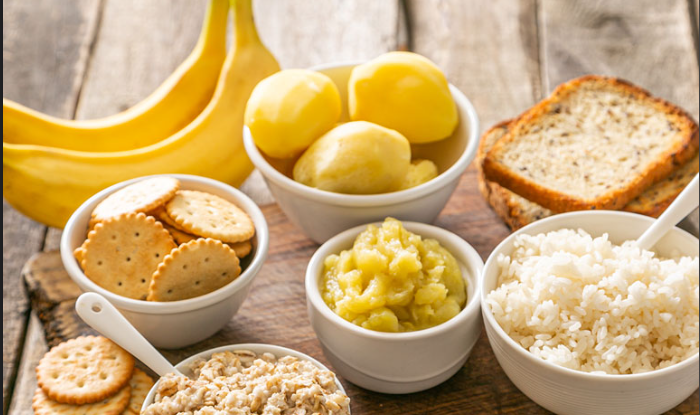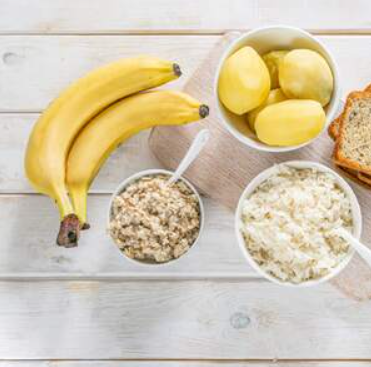The BRAT diet consists solely of toast, applesauce, rice, and bananas. Although it has been used for years to treat upset stomachs, this diet isn’t the best for treating diarrhea or stomachaches.
What is the BRAT diet?
You’ve probably heard of the BRAT diet if you or your child have ever had diarrhea or a gastrointestinal ailment. And with the flu, respiratory syncytial virus, and other ailments becoming more common among children and families during the winter, many are resorting to their mother’s time-tested remedy for unsettled tummies.
When a sick child appeared with nausea, vomiting, diarrhea, or stomachaches, the pediatrician would typically prescribe it, which stands for bananas, rice, applesauce, and toast.
Also read: Unlocking The Healing Power Of Navara Kizhi Therapy

How does the BRAT diet work?
- This diet was originally intended to be used when children experienced stomachaches, nausea, vomiting or diarrhea.
- It involves only eating four foods: bananas, rice, applesauce and toast.
- These foods were said to be good for gastrointestinal issues because they’re easier to digest than others.

Can I lose weight on the BRAT diet?
It is not advised for long-term weight loss and should not be followed religiously. Because you’ll be ingesting considerably fewer calories than usual while on it, you might unintentionally lose weight while dealing with digestive problems.
Short-Term Weight Loss
There are no studies about it or short-term weight loss since the diet shouldn’t be followed for more than 48 hours. If you’re following it for stomach problems, make sure to drink enough water and electrolytes. Otherwise, you might experience unhealthy weight loss due to dihydration during illness.
Long-Term Weight Loss
Since it is a therapeutic diet used only for short-term, acute stomach problems, there are no studies about it for long-term weight loss.
Weight Maintenance and Management
Again, it is not intended to be followed for weight management purposes. There are no studies that promote this restrictive diet as a weight-management technique.

Is the BRAT diet easy to follow?
The BRAT diet doesn’t require you to measure out calories, plan your meals ahead of time or portion carefully. Its name is an acronym for the foods you’re allowed to eat, which makes it simple to remember.
However, this won’t exactly make the BRAT diet easy to follow. Again, the diet is not recommended to be used even for short-term illness anymore, much less long-term dieting. It’ll likely be tempting to eat foods not included in the BRAT diet, even if you’re following it for a short time, since you only have four food options.

Who should not try the BRAT diet?
The AAP no longer advises anyone to follow the BRAT diet. If you or your child is suffering from gastrointestinal problems or an unsettled stomach, consider switching to a bland diet.
Experts argue that although the bland diet rules are intended for youngsters, they also apply to adults. For adults with acute diarrhea, the American Academy of Family Physicians recommends comparable measures in addition to over-the-counter anti-diarrhea medications.
Pros
- Convenient: grab-and-go options.
Cons
- Could fall short nutritionally.
- Eating out is limited.
- There is a potential for monotony unless you customize.
- There is little research to back it up.
- Unsafe for some people.
- You’ll likely get hungry.

How to get started on the BRAT diet
It’s best to consult your doctor or your child’s pediatrician if someone’s experiencing gastrointestinal issues. The BRAT diet isn’t the AAP’s recommended course of treatment for stomach issues anymore, and a doctor or pediatrician will be able to make sure that you get the right treatment for your symptoms. They’ll also be able to make sure that what you’re experiencing isn’t a sign of another medical condition that should be treated.

Success stories for the BRAT diet and tips from real people
Some people with upset stomachs may find relief with the BRAT diet, and many others have probably tried a bland or BRAT diet on their own or with their kids. Food-based cures for upset stomachs have been passed down by caretakers throughout many cultures. In Korea, children suffering from nausea or diarrhea are fed jook, a meal that resembles rice pudding. Traditional medicine has employed galls, growths on trees that contain astringent substances, to treat diarrhea.

If you have an upset stomach, it’s best to eat simple foods that you know sit well in your stomach instead of completely restricting your diet. It’s important to keep in mind that the BRAT diet may not remedy nausea, vomiting and diarrhea for some. If symptoms continue or worsen for more than a day or two, you should contact your health care provider for medical advice.

Support and resources for the BRAT diet
Since health experts don’t recommend following the BRAT diet for more than about 48 hours, there aren’t BRAT diet cookbooks, but there are cookbooks and online recipes for “bland” diets that could help with an upset stomach.

Also read: The Fallacy Of Multivitamins: Why They Aren’t The Optimal Choice For Health
images source: Google
Disclaimer: The opinions and suggestions expressed in this article are solely those of the individual analysts. These are not the opinions of HNN. For more, please consult with your doctor




































